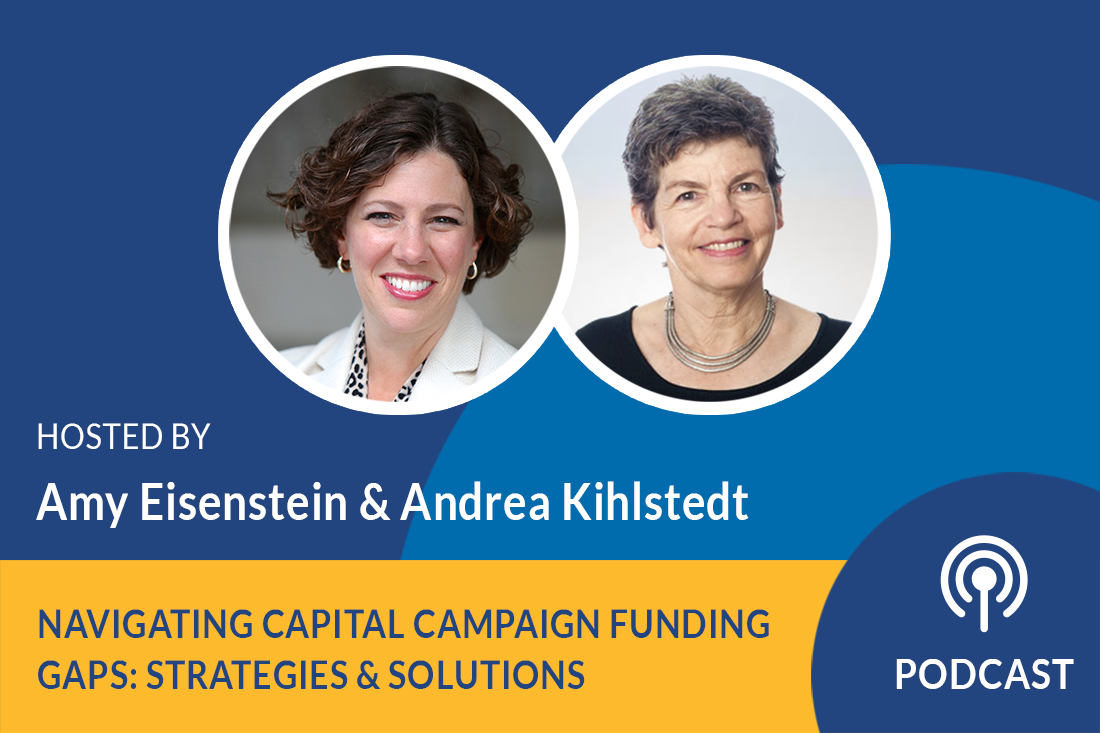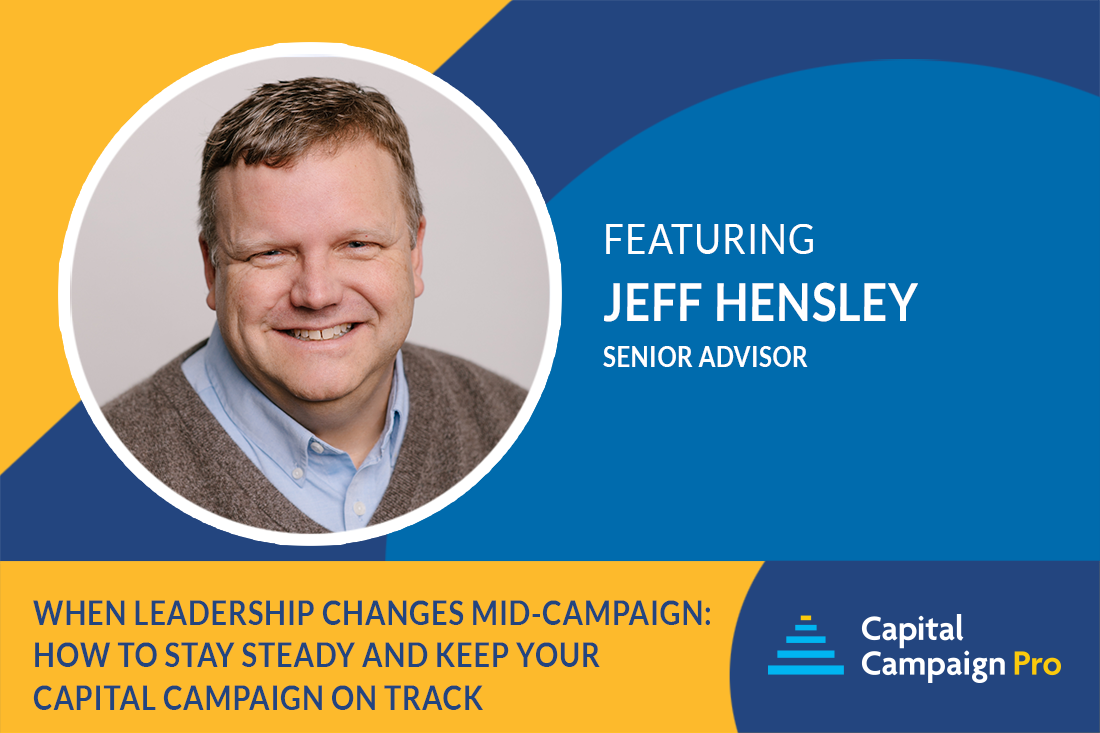Podcast: Navigating Capital Campaign Funding Gaps: Strategies & Solutions

Season 3, Episode 51
In this episode, Amy Eisenstein and Andrea Kihlstedt delve into the crucial yet often overlooked aspect of campaign goals versus project costs. While not the most glamorous topic, it’s undeniably essential for any organization embarking on a fundraising endeavor. What do you do when your project costs exceed your fundraising potential?
Join Amy and Andrea as they explore practical solutions for bridging funding gaps in capital campaigns. From leveraging cash reserves and exploring financing options to tapping into government funding, they provide valuable insights into alternative revenue streams that can supplement philanthropic contributions.
Listen Now:
Andrea Kihlstedt:
Some topics aren’t sexy, but boy are they important. That’s what we’re talking about today.
Amy Eisenstein:
Hi, I am Amy Eisenstein. I’m here with my colleague and co-founder Andrea Kihlstedt, and today we are talking about the unsexy topic of [capital] campaign goals versus project costs, and what you do when they don’t match up.
When Your Capital Campaign Goal Seems Out of Reach
Andrea, what happens if you have a big project cost like $10 million, but you can probably raise closer to $6 million? What’s an organization to do?
Andrea Kihlstedt:
Thanks, Amy. This is such a common situation where a school, for example, decides that they’re going to build a new building, a new gym, or a new art center, or do something important to their campus and they price it all out and they come up with a $10 million goal and then they go and do a feasibility study. And lo and behold, they find that it’s not likely they’re going to be able to raise that through their campaign.
Does that mean that they should stop? Well, probably not because in many campaigns, the project goal is not the same as the campaign goal. The campaign goal is an indication of how much money you can raise philanthropically for this project, and many projects have other ways of bringing in money to help pay for the larger project.
So while sometimes it makes sense to shrink the project and shrink the overall costs, in many cases it doesn’t. It makes more sense to do some financial modeling and come up with income or revenue streams that you can use to pay for the project alongside the campaign goal.
Amy Eisenstein:
Yeah. And there are lots of them, and I think that this is an interesting topic that we hear again and again. It’s a question we get asked over and over. In fact, yesterday we got asked on our monthly campaign conversations and listeners, if you’re not signed up for our live campaign conversations every month we answer listener questions live. You can find it at capitalcampaignpro.com. Under Resources, free monthly campaign conversations, and we’d love to answer your questions.
So this topic came up yesterday, but it comes up frequently also with clients on our group coaching calls and other places. So let’s talk about some alternative funding sources, potential funding sources that are not philanthropy. So they’re not part of your campaign goal, but you need them to pay for the project.
So there are lots of them. So what’s one?
Cash Reserves, Board-Restricted Funds, and Quasi Endowment Funds
Andrea Kihlstedt:
Let’s start with perhaps the most obvious one, and that is cash reserves or board restricted funds, board restricted quasi endowment funds. Some organizations are in the fortunate position of actually having some money in the bank, money for a rainy day, perhaps money for a project like this.
And this is a time for you to be talking to your board about how much money your institution can afford to take out to cover some of the costs of this project expansion. That’s a perfectly reasonable thing to talk about and a good place to look for additional funds.
Amy Eisenstein:
Yeah, I’m glad you started with that one. I almost chuckled when you said it was the most obvious. To me, the most obvious is thinking about financing, right? Because a lot of organizations don’t have that kind of reserve fund, or their reserve fund isn’t enough, and/or the board won’t let them tap the reserve fund. There’s so many scenarios where a reserve fund isn’t an option for whatever reason.
And so it is a good option to visit your local financial institutions and find out how much of a mortgage you qualify for, what kind of long-term loan options do you have.
Financial Considerations for Financing
Now, you may or may not decide to exercise this option. People at your organization may be really against debt, but I think it’s a good option for many organizations that everybody should consider. Find out:
- How much you can take out?
- What the interest rates would be?
- What the monthly payments would be to factor it in (as Andrea said to your financial modeling)?
If your fundraising either comes up short or you just are not going to get to the project cost through philanthropy, it’s important to know what your options are.
Andrea Kihlstedt:
And there’s nothing wrong with that. You may feel like it’s second-best. Well, and I suppose in some way it is fantastic if you can raise enough money to cover every cent of the project cost, but in reality, that often doesn’t happen. Even with big institutions, that often doesn’t happen.
Generally, their projects are a mix of funding sources and you need to be looking at that as well. In fact, it may be wise for you to be borrowing money if the interest rates are low and you can be making more money on the money that you raise. That makes perfectly good sense to think about that.
So if you have someone on your board or someone involved in your organization who’s good at financial modeling, who can come up with two or three different financial scenarios and help you think through what the best way to pay for this is, that’s ideal, right? And one of the ways is a campaign.
Amy Eisenstein:
Right. And I think that most sophisticated organizations do factor in debt. I mean, most businesses, most individuals who are sophisticated financially have debt and they understand that that’s part of doing business.
So try and find a board member who really understands the benefits of taking debt so that you can grow faster. I mean, that’s what it’s all about. I would imagine big organizations understand this and do not hesitate as much as probably smaller organizations do.
Government Funding
So, all right, let’s think of another way. Government funding is another source of funding for your campaign that may help with the project cost, but you may not count towards your campaign goal.
It’s not necessarily philanthropy to go to your town, your state, your county. Government funding is a part of the mix. What kind of appropriation can you get? What kind of government grants can you be applying for that would go towards your project cost but not necessarily count towards your campaign goal?
Andrea Kihlstedt:
You know Amy, it’s worth pausing for a minute to look at that because whether or not you count government grants towards your campaign goal is a matter of policy. And every campaign needs to have a set of policies that spell that out in the beginning.
Some organizations decide that they’re going to count everything towards their campaign goal and some decide that they’re not going to count, for example, government funding or other sources.
So you can make that decision either way. What matters is that upfront you make that decision and that you write it out in your campaign policies so you’re not winging it as you go.
Amy Eisenstein:
I do think that it is important to think that through as you’re developing your gift range chart. If government funding is going to be half of the overall campaign, it’s going to make for a funny and awkward gift range chart, and donor recognition won’t flow in a logical way as a result.
So that may be a factor in terms of whether or not you decide to count government funding towards your campaign goal or take it out of the campaign goal and just apply it to the project cost.
Not Every Source of Income Goes Toward Your Project
One more thing for people to think about as their wrestling with their project cost is that not every source of income will go towards every aspect of your project.
For example, certain government grants will cover capital expenses and others will cover project expenses or salaries, or — there’s plenty of examples of foundations that either will or won’t cover bricks and mortar, and you get the idea.
Andrea Kihlstedt:
I always feel like this part of a project, this part of project planning is like a jigsaw puzzle where you have many pieces that can be arranged in different ways and they fit better in some ways than in others.
Key Budgetary Considerations
So early in your campaign, this is the kind of jigsaw puzzle you’re going to be looking at:
- How much money do you really need?
- Where is that money likely to come from?
- How much of that is going to be in your campaign goal, and how much of it is going to be money in but not counted towards your campaign goal?
And each one of those questions has multiple factors that you can be thinking about that’s determined in part on the kind of organization you are and the kind of cash flow you have, for example, or the kind of capacity you think you have for a campaign.
So we’re not here to solve those or answer those questions for you today. We really are here to point out that the difference between your project cost and your campaign cost is likely to be significant. And as you’re thinking about your campaign, there’s absolutely nothing wrong with also thinking about what other revenue streams you have that you could count towards your project costs overall.
Amy Eisenstein:
Excellent. I think that’s so important.
Final Thoughts
So if you’re struggling with this, if you’re wrestling with this as you should be, as you head into a campaign, it is something that you should be discussing with your board and your leadership team.
And if you want expertise or input, head on over to the Capital Campaign Pro website, capitalcampaignpro.com, and sign up for a free strategy session where we will help you think through setting up your campaign as well as see if our services might be a good fit for supporting you and your team through a campaign. Okay, I think it’s important.
The bottom line is: have this conversation.
Don’t be flustered or upset if your project cost is more than you think you can raise. That is a frequent case that the project is more expensive than you can raise, but there are lots of alternative funding sources. That’s the good news, and if others can do it, you can too.
So thanks so much for joining us, and we’ll see you next time.



Leave a Comment